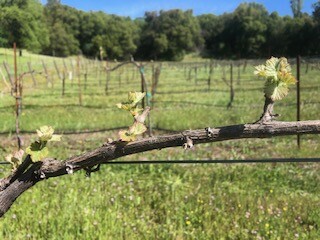
What does it mean "to prune grapevines" & why is it important?
As I walked up to the first plant in the vineyards, clippers newly sharpened to begin the spring task of pruning the grapevines, I jumped sideways being startled from a piercing screech! The corner of my eye caught a Great Blue Heron flying out from the next row up. There are many Heron on the ranch and this time of year they share their time between the vineyards where their eggs are hidden, and the pond, where the fish they eat hide below the surface.
One of the very first times I heard a Heron screech was upon my arrival to the ranch after driving from the Bay Area one Friday night after a work week. I parked down the hill from the house and the sky was pitch black, still, silent and starry. I took a deep breath of fresh air ready to have a restful weekend when out of the dark came this blood curdling scream! I had never heard that sound before and assumed it was a mountain lion or sasquatch! I was so scared I ran up the hill to the house without my feet ever touching the ground! Now, over the years, I have heard the Great Blue Heron screech many times, but can still be very startled if I am in a dreamy Zen mode trying to breath in peace along-side the vines!
So, where was I? Oh yes, you are wondering why it is important to prune grapevines! Pruning is the very first step in winemaking. Each spring grapevines sprout new buds, which become canes and produce leaves and clusters of berries, called the fruit of the vines or grape clusters. The fruit is considered higher quality if it grows from NEW wood vs. the old wood from the prior year. Pruning is the process of removing old or dead wood from the woody trunk and cordons (arms) of the grapevine and leaving just enough buds on the existing cane from which to sprout new leaves generating new canes which will produce 2-3 clusters of fruit each. If you did not remove this old wood you would have random clusters growing everywhere on the old canes, plus new canes popping up and your vines would look like a bush on a bad hair day making the clusters very small and very difficult to harvest.
The picture of the field above you depicts the new canes sprouting along the cordon of the grapevine. Each of those new leaf positions will sprout new canes and each cane will produce 2-4 clusters of grapes for the current vintage. I grow 5 different varieties of grapes on the ranch and all are pruned slightly differently, but I think you get the idea that old and dead wood must be removed each spring so the vines can freely inhale and exhale and start growing anew for the current vintage.
Pruning is also used to train the vines along a wire. Spacing the positions of the canes’ fruit for light and air flow keeps the plants fresh and free from bugs and mold. Winemakers and viticulturists become familiar with pruning techniques unique to their “terroir” or land so they can enhance the quality of the fruit for any given season.
For me, pruning is not only the first step in winemaking, but an artisanal practice where I have the first opportunity of the season to say “Hello” and “Happy New Year” and mostly “Thank You” to each and every vine that will once again put forth its best effort to produce a new crop of wine for us to enjoy with family and friends!
I look forward to updating you on any new critters in the vineyard and pictures of the growing vines as we look forward to the 2021 vintage!
Cheers!
Karen
Wine Imports to the U.S.
3yPls send me info, Marco